Wednesday, August 17, 2011
Ducks and geese use more bedding (or litter) than chickens as their droppings are wetter and they make more of a mess with their drinking water. Therefore, you may be adding bedding on a daily basis if you have a high concentration of birds in your pens. Bedding can become an expensive part of your hobby or business due to the cost of the material and the labor to add and remove it.
No matter what type of bedding you use, you must ensure it has no mold in it and it stays dry before use. The moisture from ducks and geese can produce a perfect environment for mold growth in your bedding. Aspergillosis, the most common mold, can be devastating in a flock of poultry if it starts growing in your bedding.
No matter what type of bedding you use, you must ensure it has no mold in it and it stays dry before use. The moisture from ducks and geese can produce a perfect environment for mold growth in your bedding. Aspergillosis, the most common mold, can be devastating in a flock of poultry if it starts growing in your bedding.
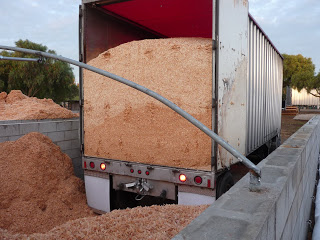
Shavings
Shavings is a very good bedding. If it is dry, it does an excellent job of absorbing moisture. It is also easy to clean out of your building - whether with a shovel or a tractor. Unfortunately it is fairly expensive. It can be purchased in bulk (loose) if you use large quantities or in bundles if you don't. There are different qualities of shavings - the best is dry and in thin slices. Thicker chunks of wood do not absorb moisture as well and do not break down in the soil as fast either. We have used a variety of woods with no apparent difference among them. We have even used redwood with our laying ducks - though that tends to stain the eggs which is not good if you are selling the eggs for eating!
You do not want to use shavings with large amounts of sawdust if it is for day old birds. They may eat the shavings which does not provide them any needed nutrients and may kill them if it swells in their gut and blocks all passage. This is rarely a problem with ducklings or goslings over one week of age. If shavings are expensive and straw is cheap, put the shavings in the nests and straw in the pen as clean eggs are critical whether you are eating them or hatching them.
Shavings is a very good bedding. If it is dry, it does an excellent job of absorbing moisture. It is also easy to clean out of your building - whether with a shovel or a tractor. Unfortunately it is fairly expensive. It can be purchased in bulk (loose) if you use large quantities or in bundles if you don't. There are different qualities of shavings - the best is dry and in thin slices. Thicker chunks of wood do not absorb moisture as well and do not break down in the soil as fast either. We have used a variety of woods with no apparent difference among them. We have even used redwood with our laying ducks - though that tends to stain the eggs which is not good if you are selling the eggs for eating!
You do not want to use shavings with large amounts of sawdust if it is for day old birds. They may eat the shavings which does not provide them any needed nutrients and may kill them if it swells in their gut and blocks all passage. This is rarely a problem with ducklings or goslings over one week of age. If shavings are expensive and straw is cheap, put the shavings in the nests and straw in the pen as clean eggs are critical whether you are eating them or hatching them.
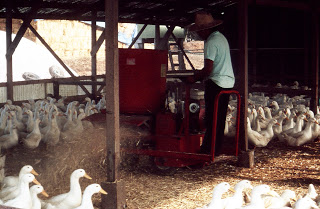
Straw
Straw is the most common type of bedding used. The advantage of straw is that is is typically inexpensive and available almost everywhere. Ducks and geese also love to dig through freshly spread straw looking for unharvested grain and other tidbits. The two main disadvantages of straw are that it is more difficult to remove from a building and it does not absorb moisture well. We have chopped it in the past and this helps with both of these problems (see the picture above). By chopping the straw, you are exposing more cut stem which can better absorb moisture and by making smaller pieces it easier to remove from your pen.
In our outdoor goose nests, we use a combination of straw and wood shavings. If we only use straw, it does not absorb moisture well. If we use shavings only, the geese dig through it to make their nest and the eggs end up being laid on dirt and all the shavings are outside the nest.
Straw is the most common type of bedding used. The advantage of straw is that is is typically inexpensive and available almost everywhere. Ducks and geese also love to dig through freshly spread straw looking for unharvested grain and other tidbits. The two main disadvantages of straw are that it is more difficult to remove from a building and it does not absorb moisture well. We have chopped it in the past and this helps with both of these problems (see the picture above). By chopping the straw, you are exposing more cut stem which can better absorb moisture and by making smaller pieces it easier to remove from your pen.
In our outdoor goose nests, we use a combination of straw and wood shavings. If we only use straw, it does not absorb moisture well. If we use shavings only, the geese dig through it to make their nest and the eggs end up being laid on dirt and all the shavings are outside the nest.
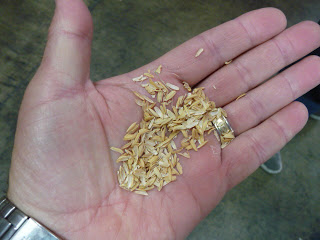
Rice Hulls
The use of rice hulls is common wherever rice is grown. It is also typically inexpensive but does not absorb moisture well and can be difficult to use because it blows easily. In my opinion, the critical necessity of rice hulls is that it is clean and mold free. Of course all bedding must be mold free but the two times we have tried rice hulls (because wood shavings were not available in the winter) we have experienced mold problems in our duck eggs. As soon as we started bedding with rice hulls, we were candling out an additional 10-15% of our eggs due to mortality form mold growing in the eggs. However, many people use rice hulls so it all depends on the cleanliness of your rice hull suppy.
The use of rice hulls is common wherever rice is grown. It is also typically inexpensive but does not absorb moisture well and can be difficult to use because it blows easily. In my opinion, the critical necessity of rice hulls is that it is clean and mold free. Of course all bedding must be mold free but the two times we have tried rice hulls (because wood shavings were not available in the winter) we have experienced mold problems in our duck eggs. As soon as we started bedding with rice hulls, we were candling out an additional 10-15% of our eggs due to mortality form mold growing in the eggs. However, many people use rice hulls so it all depends on the cleanliness of your rice hull suppy.
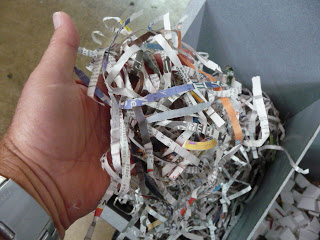
Newspaper
Some feed stores sell bales of chopped or shredded newspaper. The advantage of processed newspaper is that it absorbs moisture very well. The disadvantage is that it does not hold its form when it gets wet. It can become a very slick, wet surface with excess moisture. When we were chopping our straw before for our duck buildings, we would chop a bale of straw and then a stack of newspaper. The straw provided a fluffy structure and the newspaper did a good job of absorbing moisture. It was an excellent combination.
Some feed stores sell bales of chopped or shredded newspaper. The advantage of processed newspaper is that it absorbs moisture very well. The disadvantage is that it does not hold its form when it gets wet. It can become a very slick, wet surface with excess moisture. When we were chopping our straw before for our duck buildings, we would chop a bale of straw and then a stack of newspaper. The straw provided a fluffy structure and the newspaper did a good job of absorbing moisture. It was an excellent combination.
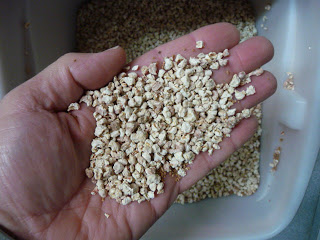
Ground Corn Cobs
Though we have not tried this product, we have read it can be used successfully for poultry bedding. As this is ground into a variety of sizes, it has been recommended that you use the smaller sized pieces, 1/4" or less. It has been shown that ground corn cobs will absorb more moisture per pound than shavings, straw, leaves or newspaper.
Though we have not tried this product, we have read it can be used successfully for poultry bedding. As this is ground into a variety of sizes, it has been recommended that you use the smaller sized pieces, 1/4" or less. It has been shown that ground corn cobs will absorb more moisture per pound than shavings, straw, leaves or newspaper.
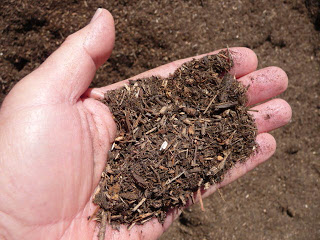
Other Products
We sell our manure/bedding to a composter and he suggested we try a product he gets from municipal green waste sites. After branches and leaves and other plant materials are chopped, the material is screened by size. We are now trying the smallest sized material. The sample we received is dry but heavy. He hopes we can use it as the pieces are smaller than shavings and break down more completely in his composting process - enabling him to make a more salable product. In addition, it is much less expensive for us than wood shavings. We will let you know how this product works.
Research has been done on cotton milling waste and leaves, with both showing promise as a poultry litter, too.
Final Bedding Criteria
Absorbs moisture
Must be free of molds
Keep dry before use
Easy to handle and use
Is not harmful to the birds if it is eaten
Will decompose once it is removed from your pens
What works well for you and why?
We sell our manure/bedding to a composter and he suggested we try a product he gets from municipal green waste sites. After branches and leaves and other plant materials are chopped, the material is screened by size. We are now trying the smallest sized material. The sample we received is dry but heavy. He hopes we can use it as the pieces are smaller than shavings and break down more completely in his composting process - enabling him to make a more salable product. In addition, it is much less expensive for us than wood shavings. We will let you know how this product works.
Research has been done on cotton milling waste and leaves, with both showing promise as a poultry litter, too.
Final Bedding Criteria
Absorbs moisture
Must be free of molds
Keep dry before use
Easy to handle and use
Is not harmful to the birds if it is eaten
Will decompose once it is removed from your pens
What works well for you and why?
Comments
We read about hemp bedding, and decided to try it with our ducklings. It's supposed to be healthier (less dust) than some other bedding, per the retailers. We do think it has somewhat less dust. It absorbs moisture really well; however, it's way more expensive than wood shavings, and doesn't help much with the smell. Overall, I'm not sure that it's worth the extra cost.
Cassie, Wednesday, May 3, 2023